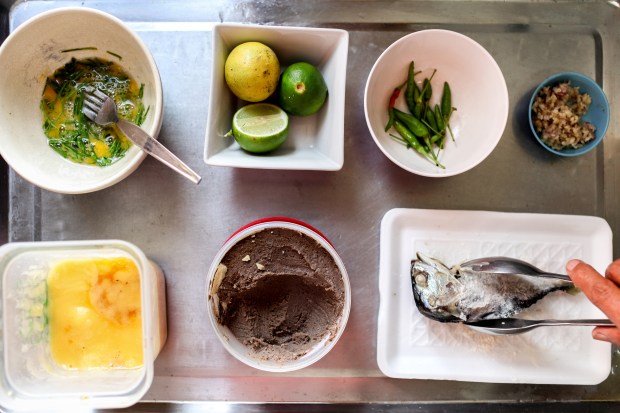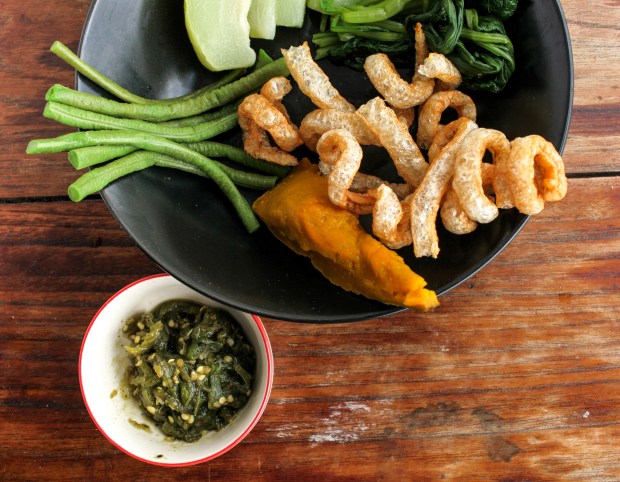Tradition has it that by five in the evening, the sound of a dull, rhythmic thwacking would emanate from homes in every village in Thailand as women began to prepare dinner. Every dinner was expected to have a soup or curry, a stir-fry dish, a salad, a chili dip or nam prik (chili relish), and a big bowl of rice, and almost every dish was expected to be made from scratch with a hand-pounded chili paste for the base.
Sauce is said to be the soul of French cuisine, but in Thailand chili paste forms the heart of nearly every dish. It is considered one of the defining characteristics of Thai food—along with fish sauce, a natural sour ingredient such as tamarind or lime, an unscented oil, and cooking meat on the bone. According to Thai-food expert and celebrity cook Chef McDang, chili dips may have started when Thai workers needed a portable form of protein that could be stretched with a mix of herbs and chilies to take into the fields. The spicier dips were considered more economical, since more (and relatively cheaper) rice would be needed to alleviate the heat, filling you up more quickly.
As a result, it is the mortar and pestle, not the knife, that every serious Thai chef prizes above all other tools in the kit. Most cooks firmly believe that food processors will not do; only intense bouts of pounding can release the essential oils trapped in the herbs and spices of every Thai paste, lending a depth of flavor that chopping merely hints at.

In fact, the method for pounding the paste was considered so integral to the home that it was said a Thai man chose his bride solely for the sound she made with her mortar and pestle. Short, sharp whacks of barely controlled aggression were ideal. Not surprisingly, the emphasis on women in the kitchen led to other cooking-related euphemisms in Thai conversation: a womanizer was referred to as a nah maw (pot face); a man who cheated on his wife was said to have “tasted another woman’s nam prik.”
There are myriad versions of paste. It can form either the base of a soup, curry, or stir-fry or the marinade for chicken, pork, or fish. It can also be the dip itself, surrounded by the cooked and raw vegetables that best accompany it. Most pastes not used as base dips, however, are made with fresh herbs and spices such as coriander root, shallots, and chilies. They feature some type of protein, and they are pounded in a mortar and pestle of polished stone strong enough to crush stubborn ingredients into the desired pulp.

Just as Thailand can be roughly divided into four regions (Central, Northern, Northeastern, Southern) with distinct characteristics, pastes can be separated into four regional groups. In the fertile Central region, considered Thailand’s “rice bowl,” Thais (mostly from Bangkok) like to say food has a rounded, more sophisticated flavor, perhaps reflecting its proximity to the Royal Court.

The base for many Central Thai dishes is kapi (shrimp paste), which gives a pungent yet slightly sweet flavor to everything it touches. The best kapi hails from Samut Songkhram, a province just south of Bangkok, which is rich in the tiny shrimp that live in the region’s shallow waters. The shrimp are mixed with sea salt, dried for several days, forced through a sieve, and then set aside to ferment for a few weeks before being packaged and sold. Some of Thailand’s most famous dishes prominently feature kapi. Nam prik kapi, for example, is a chili dip accompanied by fried mackerel, omelet, and boiled vegetables like okra, cabbage, and winged beans. It makes for a well-rounded meal when served with the requisite rice.
Even royalty ate such traditionally humble dishes as nam prik. The dip called nam prik long ruea (chili dip in a boat) was concocted for a Thai princess and included nam prik kapi, syrupy sweet cooked pork, and deep-fried fish floss, resulting in a flavor meant to be equally salty, sweet, and tart. The expected accompaniments are appropriately elaborate: pickled garlic, salted duck-egg yolks, fresh slivers of white turmeric, and fresh coriander leaves.
In the seafood-rich South, where Malay influence is strong and the food is so spicy it can make you cry, the regional ingredient most analogous to kapi is nam bu do. It is made from fermented fish, salt, and water and bears a characteristic sweet-salty flavor. It is popular as a base in soups, stir-fries, and chili dips, but it is considered indispensable in khao yum, a rice salad mixed with nam bu do, minced lime leaves and lemongrass, shredded coconut, chilies, lime juice, and dried shrimp.
In Northeastern Thailand, also known as “Isan,” Laotian influence predominates. The base of every dish in Isan is pla rah, or fermented freshwater fish mixed with rice bran or powder and left to develop a uniquely funky twang. Said to have been created by accident in the Mekong Basin, pla rah is now considered essential; no dish is fully Isan without it.
Pla rah also figures in som tum (green papaya salad) and flavors dipping sauces for grilled meat or fish encrusted in salt. Of course it can be made into a chili dip when mixed with shredded cooked fish, chilies, garlic, and shallots.

It might be in the Northern region, centered around the former Lanna capital of Chiang Mai, where paste-based chili dips fully reign. Despite the popularity of khao soy, or curried egg noodles, the flavors of the North are typically fattier and meatier due to the relatively cooler weather. Dinner tables hold grilled and fried meats (especially pork), minced-meat salads, sausage, as well as bitter or tannic leaves and vegetables foraged from the nearby mountains, generously showered with deep-fried pork rinds for added texture. All of this is frequently seasoned with liberal doses of nam dee (cow bile) or pig’s blood, resulting in a heartier flavor profile that toes the line between salty and spicy against a backbone of bitter.

These types of dishes naturally cry out for chili pastes you can dip your deep-fried pork rinds and fried bits of meat into, as well as for use in marinades, stir-fries, and soup bases. It’s no accident that some of the region’s most famous dishes are chili dips: nam prik num, made from mashed roasted young chilies, shallots, and garlic flavored with fish sauce and lime juice; nam prik tha dang (red-eye chili dip), a fiery mixture of dried chilies, garlic, fish sauce, and lime juice; and the ragulike nam prik ong, stir-fried chilies, garlic, shallots, shrimp paste, and ground pork mixed with cherry tomatoes and chopped fresh coriander, which is ubiquitous at every khanthoke (formal Northern Thai) dinner.
Northern Thais also have their own versions of kapi, which provides the necessary base note to most dishes. Because the region is landlocked, Northern Thais had to rely on crabs in the rice fields to provide the umami usually supplied by kapi. During the rainy season, from June through August, when the crabs are especially numerous, they are pulverized, preserved, and slowly cooked to form nam poo, the distinctive crab paste with a deep-black color that flavors chili dips and salads.